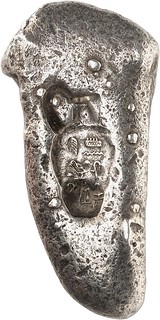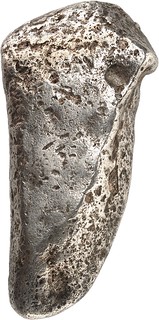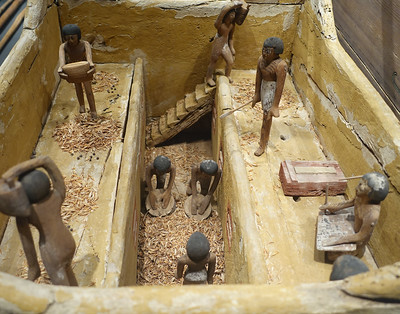
PREV ARTICLE
NEXT ARTICLE
FULL ISSUE
PREV FULL ISSUE
TUTANKHAMUN-ERA SILVER BAR OFFEREDThis press release describes a very interesting silver bar from the reign of Tutankhamun offered by Numismatica Genevensis SA. -Editor Do We Have to Predate the Beginning of Coinage by Half a Millennium? Auction house Numismatica Genevensis SA offers in its auction 12 on 18 and 19 November 2019 an object that might revolutionize monetary history as we know it. Did the Egyptians of the 18th dynasty already use coins? On 18 November 2019, auction house Numismatica Genevensis SA in Geneva will offer an object – No. 101 – that will dispute our version of monetary history. The object in question is a silver bar with a cartouche bearing the name of Pharaoh Tutankhamun. This bar has the weight of half a deben which means it was issued in a weight unit corresponding to the currency of account in ancient Egypt. So, do we have to predate the beginning of coinage by more than half a millennium? Were ancient pharaohs already familiar with the concept of "coins"?   Tutankhamun, around 1345–1327 BC. Silver bar weighing about half a deben. Produced in a Phoenician trading house or in Lebanon. Drop-shaped flan with a cartouche in the form of a jug, in it the legend "Tutankhamun, ruler of Heliopolis in Upper Egypt" written in hieroglyphs. 41.55 g. Valloggia, bar A (this specimen). The Object
Its weight of 41.55 g differs by 8.7% from 45.5 g – which would be the weight of half a deben or 5 kites. Such a deviation is quite acceptable, as we know from other numismatic epochs. The cartouche in the form of a jug bears the name of Pharaoh Tutankhamun and calls him ruler of Heliopolis in Upper Egypt. The inscription supplies us with a date: Tutankhamun reigned between 1345 and 1327 BC. The bar offered at Numismatica Genevensis SA is one of two pieces from the collection of Roger Pereire, who died already in 1968. His daughter sold her father's collection at the beginning of the 70s. Since then, the silver bar has been part of a Swiss private collection. The Egyptian Currency System
Prices of everyday goods, wages and units of account, which were used to calculate the former two, are written on hundreds of ostraka from the workers' village on the West Bank of Thebes. Craftsmen and merchants of the New Kingdom calculated in silver, copper and grains – depending on the value of the good. Larger sums were expressed in silver, everyday sums in copper and small amounts in grains. In very rare cases, the price was even indicated in debens of gold. In addition to debens of silver, also shenati of silver were used on the West Bank of Thebes – these units were worth at first 5 and later 4 debens of copper.  A scribe in the granary writes down exactly how much grain has been delivered. From the burial equipment of a Gemniemhat. Saqqara, around 1990 BC. Ny Carlsberg Glyptothek. Photo: UK. Twenty Pieces of Silver for the Slave Joseph
A bill to Erenofre, a lady of a house who bought a female slave, proves that ordinary people used debens and kites for their calculations, too. The cost amounted to 5 debens of silver. She made use of the content of her linen cupboard in order to get the money together and gave the merchant a blanket of Upper Egyptian cloth worth 3 1/3 kites of silver, a djayt garment of Upper Egyptian cloth worth 4 kites of silver, a dress of fine Upper Egyptian cloth worth 5 kites of silver and several further objects until the amount of 5 debens of silver was paid. The step from such a sophisticated accounting system to small silver bars worth half a deben is quite small. And actually, this would make a story that has been known to us for centuries appear in a completely new light – at least in terms of its significance for monetary history: The book of Genesis (Gen 37.28) describes how Joseph was sold to Midianites merchantmen. 20 pieces of silver changed hands. Until now, we interpreted them as pieces of raw silver, which were weighed after handing them over. However, if that was correct, wouldn't it have been more logical to speak of their weight instead of their number? And considering that the Egyptian woman paid five debens for the young female slave, these silver pieces could well have been small bars worth half a deben. Relations of price are quite stable. So, when the Edict on Maximum Prices of Diocletian was written, the value of male slaves still was 30 to 50% higher than the value of female slaves – therefore, the price of 10 debens of silver for a strong male slave would be quite realistic. A Thief Stole a Sack Full of Pieces of Silver
Are There No Similar Pieces or Have They Simply Not Been Taken into Account Yet?
A New Picture of Monetary History
For even though this spectacular bar might have laid the foundation of a working coinage system, the Greeks made this idea suitable for daily use. Literature:
David M. Schaps, The Invention of Coinage and the Monetization of Ancient Greece. Ann Arbor 2007. Michel Valloggia, Note sur deux lingot d'argent de Toutânkhamon, Revue d'égyptologie 68 (2017-2018), pp. 141–152. To vist the Numismatica Genevensis SA web site, see:
THE BOOK BAZARREWayne Homren, Editor The Numismatic Bibliomania Society is a non-profit organization promoting numismatic literature. See our web site at coinbooks.org. To submit items for publication in The E-Sylum, write to the Editor at this address: whomren@gmail.com To subscribe go to: https://my.binhost.com/lists/listinfo/esylum All Rights Reserved. NBS Home Page Contact the NBS webmaster 
|